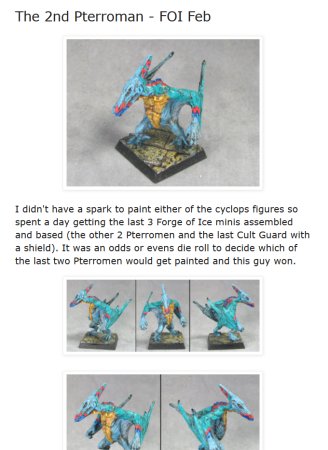Painting dungeon doors is neither hard nor glamorous, but it's good to go over basic techniques from time to time for the benefit of newer gamers. And I expect that the experts among us can give me a tip or two!

In the Dwarven Forge dungeon system, doors are not built into the dungeon tiles, but instead are 'drop in' pieces that sit on top of the tiles. The door comes pre-assembled, and consists of doorway and door; it looks to me like the doorway consists of at least two separate pieces, glued at the factory (the 'top' piece that holds the door in place). I could tell this because one of my doors had a glue failure, with the glue slipping down and actually gluing the door into place!
My first step is to disassemble the door, which I find makes them a lot easier to paint. The PVC-like material they are made from is rubbery, and by carefully bending the doorframe, you can pop out the doors.
The doorframes are painted just like any other dungeon tile – see my previous article.
For the doors, I start by basecoating them with ColorPlace Flat White spray paint, the inexpensive brand they sell at Walmart. The PVC-like material does not need to be primed, so this step is just to give them a brighter foundation to work with. I also could have basecoated them with flat brown, which would have saved me a step!
Oddly enough, the spray paint did not respond well to the door material, and came out a bit glossy. I don't have enough experience yet to know if this was just a fluke, or a general problem between these two products.
I'm a huge fan of Coat d'Arms paints. This is an old paint bottle on its last legs, and I don't even know what color it would be in the catalog. I've simply painted the door brown. Because of the glossiness of my flat white paint, I have to watch out for the brown paint doing some weird kind of surface tension thing and unpainting itself! The best technique is to first paint around the door pins, then hold the piece by the pins and paint one side; paint the other side when the first side dries; then touch up as needed.
Next, I paint the 'metal' parts flat black, using Coat d'Arms 102 Flat Black. This is the new-style bottle, and as you can see, the flip-top sometimes dribbles down the back of the bottle. (Also, I painted the top of the lid so I can tell the pots apart easier.) I figure it is better to paint the black now, rather than wait for later when it might accidentally cover drybrushing or washes.
I recommend being neat when you paint the black, but if you are sloppy, the later steps generally cover up your mistakes.
Now, I drybrush the entire door with FolkArt 953 Camel (an inexpensive craft paint). You can try to avoid getting the black parts, but it won't matter if you do.
Now I hit the door with Coat d'Arms 421 Super Shader Dark Brown. I have just started using this product, to replace some Flesh Wash that I finally ran out of (and is no longer produced). According to the calaog, Super Shaders are "…acrylic stains which are designed to produce highlighting and shading when painted over a simply block painted figures." I brush this on one side and the edges, making sure that it flows into all the crevices, and let it dry; then I brush it on the other side.
The previous steps have, by serendipity, give our metalwork an interesting treatment as well. All I feel to do is add some metallic drybrushing with FolkArt Gunmetal Gray (a craft paint). (I really need to get a new set of quality metallic paints, my old ones in dropper-type bottles have clogged up…)
Now, what to do about the door pins? Putting any paint on them makes them thicker and more likely to strip the paint as the doors get opened and closed; but leaving them white makes them kind of obvious. So I've painted them black.
One question I've skipped: Do these doors have any kind of lock plate around the keyhole, and if so, should it be painted? On a few doors, I tried painting in a metallic panel, but gave it up as unneeded. I just try to make sure the keyhole gets hit with the wash, so it stands out.
Because I know the doors are going to get a lot of handling in play, I seal them with a good coat of clear matte. Re-assembling them takes a bit of patience: Insert the top door pin into the doorframe, bend the doorframe back, and gently slide the door until the bottom pin fits into the hole in the base, making sure the door ends up on the right side of the doorstop. Then check the door for any damage, and touch up as needed. Optionally, you could put a bit of lubricant into the holes before assembly.
I'm about two-thirds of the way through the project of painting all the doors for my dungeon. I do them in batches of five at a time, because the step of painting the black takes care and doing more than five at a time makes me cross.
I was surprised to stumble over the original, prototype door that I painted up months ago. I thought I was following the same technique, but they look nothing alike! ![]() Just goes to show there's more than one way to paint a dungeon door…
Just goes to show there's more than one way to paint a dungeon door…







